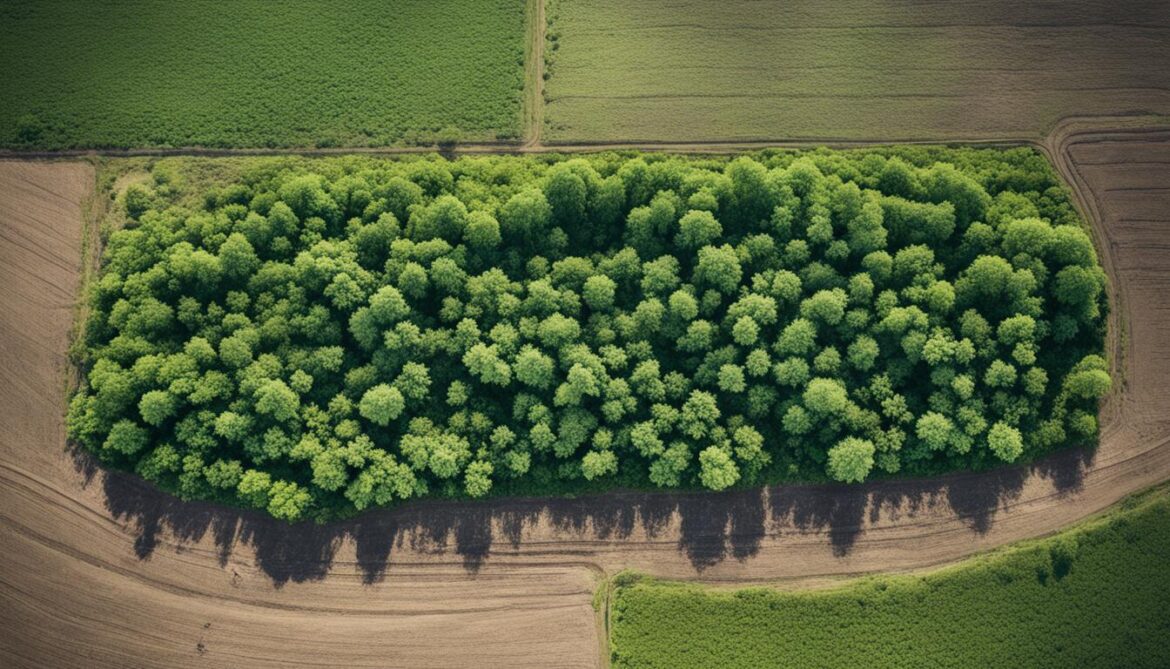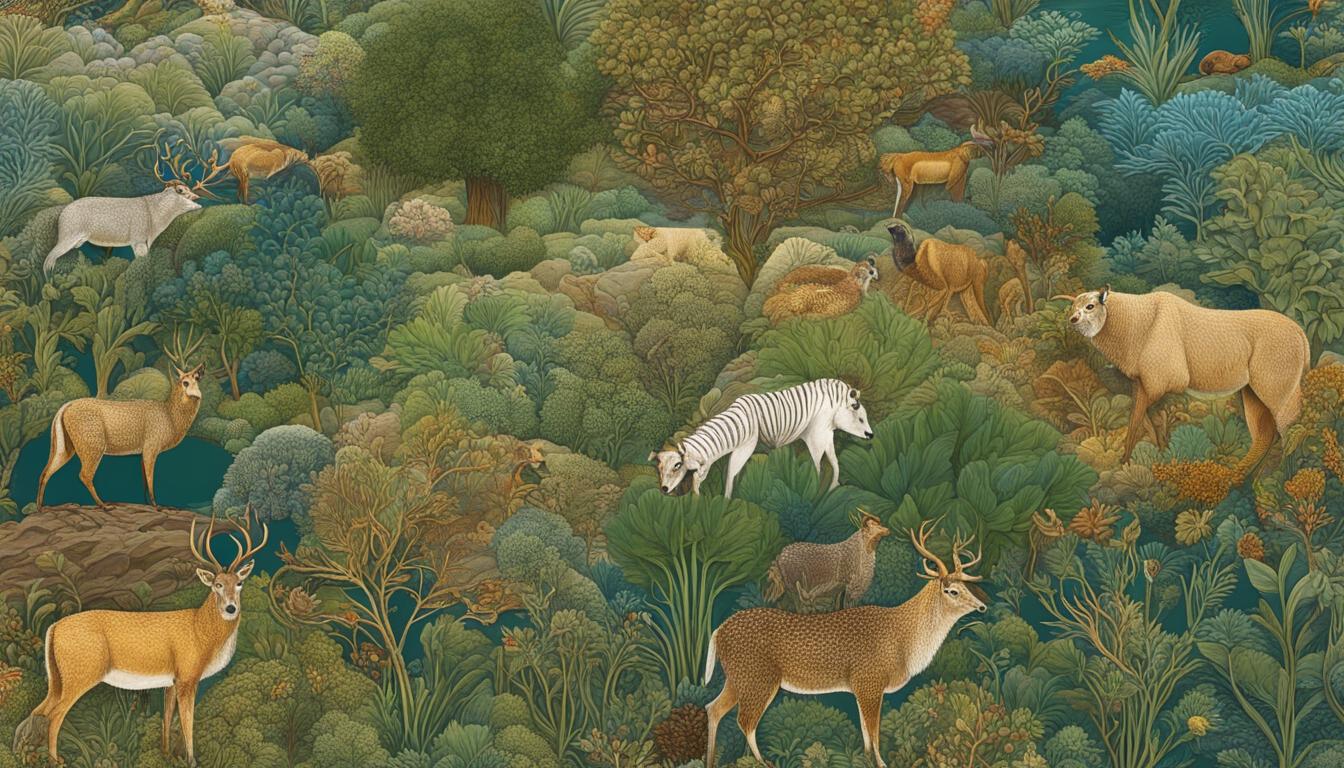Estonia Biodiversity: Animal and Plant Species and What Is Under Threat
Estonia, being the smallest and the northernmost state of the Baltic States, is known for preserving a relatively high proportion of its natural environment compared to the rest of Europe. It is home to an estimated 40,000 species, with 23,500 species identified as of 2008. However, 15% of the assessed species are either endangered or extinct.
Key Takeaways:
- Estonia is home to an estimated 40,000 species.
- 15% of the assessed species in Estonia are endangered or extinct.
- The Estonian cow and Estonian horse are among the world’s most endangered animal breeds.
- Estonia has designated 570 protected species.
- Efforts are being made to conserve and protect Estonia’s biodiversity.
Status and Trends of Biodiversity
Estonia boasts a diverse landscape molded by natural progression and human activities. With its two distinct climatic biogeographical attributes, maritime in the west and continental in the east, the country showcases a rich tapestry of ecosystems. Estonia is characterized by two types of base rocks: Silurian limestone in the north and Devonian sandstone in the south, which contribute to its geological diversity. Wetlands of international importance, including crucial waterfowl habitats, are prevalent in Estonia, highlighting its role in supporting distinct biodiversity.
Despite its natural richness, Estonia faces challenges in maintaining its biodiversity. Natural grasslands and old forests are dwindling due to agricultural practices and heightened interest in forestry. The use of intensive production farming methods has resulted in pollution, soil degradation, and habitat destruction, posing threats to the delicate ecosystems and rare species.
“Estonia’s diverse landscape and unique climatic attributes contribute to its significant biodiversity. However, unsustainable practices such as intensive farming and increased forestry pose risks to its natural heritage.”
To assess the status and trends of biodiversity in Estonia, regular monitoring and assessment are carried out. Biodiversity assessments in Estonia help evaluate the population sizes, distributions, and overall health of various species and ecosystems. These assessments play a crucial role in shaping conservation strategies and policies, aiding in the protection and preservation of Estonia’s natural heritage.
Biodiversity Facts:
- Estonia showcases a diverse landscape with two distinct climatic biogeographical attributes.
- Wetlands of international importance, including waterfowl habitats, are found in Estonia.
- Intensive agricultural practices and increased interest in forestry have led to the decline of natural grasslands and old forests.
- Biodiversity assessments play a vital role in monitoring and evaluating the status and trends of biodiversity in Estonia.
| Bioassessment Category | Number of Protected Species |
|---|---|
| Category I | 35 plant species, 18 animal species, 9 fungi species, 1 lichen species |
| Category II | 262 species |
| Category III | 244 species |
Threats to Biodiversity
Biodiversity in Estonia faces multiple threats from various factors that impact its delicate ecosystems and unique species. Understanding and addressing these pressures is crucial to preserving Estonia’s rich biodiversity.
Main Pressures on Biodiversity
Intensive agricultural practices pose a significant threat to Estonia’s biodiversity. The reliance on modern farming techniques, including the use of synthetic fertilizers and pesticides, can lead to the loss of natural habitats, soil degradation, and contamination of water bodies.
Economic globalization and trade subsidies are additional drivers of change in Estonia. They can result in increased demand for natural resources, leading to habitat destruction and loss of biodiversity. These factors can also contribute to increased deforestation, negatively impacting forest-dwelling species.
Drivers of Change in Estonia
Overfishing, eutrophication, and the spread of alien species further endanger Estonia’s biodiversity. Overfishing disrupts aquatic ecosystems and depletes populations of important fish species. Eutrophication, caused by agricultural runoff, leads to excessive nutrient enrichment in water bodies, resulting in harmful algal blooms and oxygen depletion.
The introduction of alien species can have dire consequences for native species and ecosystems. These invasive species often outcompete native organisms for resources and disrupt delicate ecological balances.
Air pollution, driven by industrial activities and transportation, is another significant threat to Estonia’s biodiversity. It can result in the degradation of air quality, leading to negative health impacts for both humans and wildlife. Air pollution can contribute to the extinction of vulnerable species and cause habitat fragmentation, particularly in coastal areas.
Expected Impact of Climate Change
The changing climate in Estonia is expected to exacerbate existing threats to biodiversity. It will likely increase the spread of alien species and further contribute to habitat destruction, particularly in coastal areas. Rising sea levels, extreme weather events, and changing precipitation patterns can all have significant consequences for Estonia’s fragile ecosystems.
Addressing these threats and implementing sustainable practices is crucial to protect Estonia’s biodiversity. Conservation efforts, public awareness campaigns, and policy changes can help mitigate the pressures on biodiversity and ensure a sustainable future for Estonia’s unique ecosystems.

| Threats | Main Pressures |
|---|---|
| Intensive agricultural practices | – Synthetic fertilizers and pesticides – Habitat loss – Soil degradation |
| Economic globalization and trade subsidies | – Increased demand for natural resources – Habitat destruction and loss of biodiversity – Deforestation |
| Overfishing | – Disruption of aquatic ecosystems – Depletion of fish populations |
| Eutrophication | – Agricultural runoff – Harmful algal blooms – Oxygen depletion |
| Spread of alien species | – Competition with native species – Disruption of ecological balances |
| Air pollution | – Industrial and transportation emissions – Extinction of vulnerable species – Habitat fragmentation |
| Climate change | – Increased spread of alien species – Habitat destruction in coastal areas |
Conservation Efforts in Estonia
Estonia, as a signatory of the Convention on Biological Diversity since 1994, has been actively implementing measures to enhance its commitment to nature conservation and biodiversity preservation. The country’s dedicated efforts in this area are evident through various initiatives and plans.
One of the key strategies in place is the Nature Conservation Development Plan, which provides a comprehensive framework for addressing a wide range of biodiversity-related challenges up until 2020. This plan encompasses diverse aspects of biodiversity management, ensuring a holistic approach to conservation efforts in Estonia.
The integration of biodiversity and ecosystem services into several state strategies and development plans further emphasizes Estonia’s commitment to sustainability. By incorporating conservation considerations across different sectors, the country aims to ensure that biodiversity protection is a central pillar of its overall development agenda.
Estonia has made significant progress in achieving the 2020 Aichi Biodiversity Targets. One notable achievement is the establishment and expansion of protected areas, safeguarding critical habitats and enhancing species conservation efforts. Additionally, measures to control invasive alien species have been implemented, addressing a major threat to native biodiversity in the country.
Recognizing the importance of collaboration, Estonia has provided subsidies to support the maintenance of semi-natural communities. Conservation agreements with private landowners have also been fostered, promoting voluntary participation and active engagement in preserving Estonia’s natural heritage.
Estonia’s commitment to the implementation of the Convention on Biological Diversity is exemplified through its comprehensive plans, increased protected areas, and collaborative efforts with landowners. These conservation endeavors lay a strong foundation for the sustainable management and preservation of Estonia’s rich biodiversity.
Conservation Efforts in Estonia
| Conservation Measures | Impact |
|---|---|
| Nature Conservation Development Plan | Comprehensive framework for addressing biodiversity challenges |
| Integration of Biodiversity into State Strategies | Promotes sustainable development practices |
| Establishment of Protected Areas | Safeguards critical habitats and species |
| Invasive Alien Species Control | Reduces threats to native biodiversity |
| Subsidies for Semi-Natural Community Maintenance | Supports biodiversity-friendly land management |
| Conservation Agreements with Private Landowners | Promotes voluntary participation in conservation |

The image above highlights the diverse and interconnected conservation efforts undertaken in Estonia. From the comprehensive nature conservation plan to the establishment of protected areas and collaborative partnerships, these initiatives demonstrate Estonia’s dedication to protecting its unique biodiversity and ensuring the long-term sustainability of its ecosystems.
Impacts of Biodiversity Loss
Biodiversity loss in Estonia has far-reaching consequences for both the environment and human well-being. The effects of biodiversity loss can be observed across various ecosystems, including wetlands, forests, and water bodies.
One of the most significant impacts of biodiversity loss is the decline in population numbers of native species. As habitats are destroyed and ecosystems are disrupted, many species struggle to survive, leading to a loss of valuable biodiversity.
Moreover, biodiversity loss alters food webs, causing imbalances and disruptions in ecological relationships. This can have cascading effects throughout an entire ecosystem, affecting the stability and functioning of natural processes.
Another consequence of biodiversity loss is the reduced resilience of ecosystems to environmental change. Biodiverse ecosystems are generally more adaptable and better equipped to withstand disturbances such as climate change. However, as biodiversity declines, ecosystems become more vulnerable to these changes.
Furthermore, biodiversity loss hampers the important process of carbon sequestration, where plants absorb and store carbon dioxide from the atmosphere. With fewer plants and less diverse vegetation, the capacity of ecosystems to sequester carbon is diminished.
These environmental impacts of biodiversity loss have direct and indirect negative implications for human well-being. Declines in ecosystem services such as pollination, water purification, and nutrient cycling can affect agricultural productivity, leading to reduced food security and economic losses, negatively impacting the livelihoods of local communities.
Biodiversity loss also has implications for the tourism industry, as the unique natural landscapes and diverse wildlife that attract visitors are compromised. Reduced biodiversity diminishes the value and appeal of Estonia’s natural attractions, resulting in potential economic losses in the tourism sector.

Overall, the consequences of biodiversity loss in Estonia are multifaceted, encompassing both the natural environment and human societies. To mitigate these impacts, it is imperative to prioritize the conservation and restoration of biodiversity, implementing sustainable practices and policies that protect ecosystems and their invaluable services.
Water Pollution and Its Impacts
Water pollution in Estonia is a significant environmental concern that poses numerous risks to both the ecosystem and human health. It is primarily caused by agricultural runoff, industrial discharges, and municipal waste, which introduce various pollutants into water bodies.
This pollution has detrimental effects on aquatic life, leading to the decline of fish populations, the disruption of aquatic food chains, and the loss of biodiversity. Additionally, water pollution contaminates drinking water sources, compromising access to clean and safe water for communities.
Moreover, water pollution hampers recreational activities such as swimming, boating, and fishing, as polluted water can cause skin rashes, stomach illnesses, and other health issues. This not only affects the enjoyment of natural water resources but also has economic implications for tourism and local businesses.
Eutrophication is another consequence of water pollution, primarily caused by excessive nutrient runoff from agriculture. This leads to an overgrowth of algae and other aquatic plants, depleting oxygen levels and suffocating aquatic life.
The impacts of water pollution extend beyond individual water bodies. It can result in the degradation of entire ecosystems, as pollution disrupts the functioning and balance of natural habitats. This can have far-reaching consequences for species that depend on these habitats for survival.
To protect Estonia’s biodiversity and ensure the availability of clean water resources, effective management, and prevention of water pollution are paramount. It requires stringent regulation and enforcement of pollution control measures in industries and agriculture, as well as the improvement of waste treatment and disposal systems.

Air Pollution and Its Consequences
Estonia’s heavy dependence on oil shale for energy production has resulted in high levels of air pollution. Air pollution has significant impacts on human health, including respiratory problems and cardiovascular diseases. It also harms ecosystems, contributes to climate change, causes soil contamination, reduces visibility, and damages property. To mitigate the effects of air pollution, Estonia needs to transition towards cleaner energy sources, improve emissions standards, and implement effective air quality management measures.
Air pollution in Estonia poses a threat to both human well-being and the country’s biodiversity. The release of pollutants into the air can have detrimental effects on respiratory health, leading to an increase in respiratory problems and cardiovascular diseases among the population. Additionally, air pollution can negatively impact ecosystems, disrupting the delicate balance of the natural environment and posing risks to wildlife and plant species.
One of the significant consequences of air pollution is its contribution to climate change. The release of greenhouse gases and other pollutants into the atmosphere contributes to the warming of the planet, leading to various climate-related problems such as rising temperatures, extreme weather events, and sea-level rise. These changes can have far-reaching consequences for both human societies and natural ecosystems.
Air pollution also has a direct impact on soil quality and contamination. Pollutants emitted into the air can settle onto the ground, contaminating the soil and reducing its fertility. This can have detrimental effects on agricultural productivity and the health of plants and crops, leading to potential food security concerns.
Reduced visibility due to air pollution is another consequence that affects both aesthetics and safety. Pollutants in the air can scatter and absorb sunlight, leading to decreased visibility and hazy conditions. This can have implications for transportation safety, outdoor activities, and tourism.
| Effects of Air Pollution | Contribution to Biodiversity Loss |
|---|---|
| Respiratory problems and cardiovascular diseases | Disruption of ecosystem balance |
| Climate change | Risk to wildlife and plant species |
| Soil contamination and reduced fertility | Threat to biodiversity conservation efforts |
| Reduced visibility | Impact on aesthetic value and tourism |
Addressing air pollution in Estonia requires a multi-faceted approach. Transitioning towards cleaner energy sources, such as renewable energy, can help reduce the reliance on fossil fuels and decrease air pollutant emissions. Additionally, implementing stricter emissions standards for industries and vehicles can help limit the release of harmful pollutants into the air.
Effective air quality management measures, including monitoring and regulation, are essential for ensuring compliance with emission standards and identifying areas where pollution levels are high. This will enable targeted actions to reduce pollution concentrations and protect both human health and the environment.
In conclusion, tackling air pollution in Estonia is vital to safeguard both human health and the country’s biodiversity. By transitioning to cleaner energy sources, improving emissions standards, and implementing effective air quality management measures, Estonia can mitigate the negative consequences of air pollution and ensure a healthier and more sustainable future for all.

Soil Degradation and its Implications
Intensive agricultural practices, deforestation, and urbanization have contributed to the degradation of soil in Estonia. These activities have had adverse consequences on the country’s biodiversity and agricultural sustainability. The consequences of soil degradation are profound and impact various aspects of the environment and ecosystems.
One of the primary consequences of soil degradation is reduced agricultural productivity, which hinders crop yields and poses challenges to food production. Nutrient depletion within the soil further exacerbates this issue, as essential elements that support plant growth become scarce. As a result, the ability of the soil to adequately sustain vegetation and support the diverse plant species present in Estonia is significantly compromised.
Soil degradation also has detrimental effects on biodiversity and ecosystem health. As the soil undergoes degradation, its pH levels and nutrient balance become altered, creating an environment that is less conducive to supporting a diverse range of plant and animal species. This leads to a decline in biodiversity as certain species struggle to adapt and thrive in the modified soil conditions.
To address the issue of soil degradation, it is crucial to implement sustainable land use practices. These practices include soil conservation techniques and proper land management strategies that prioritize long-term soil health and fertility. By adopting these practices, Estonia can protect and preserve its soils, ensuring the continued well-being of its biodiversity and supporting its agricultural sector.
| Consequences of Soil Degradation in Estonia | |
|---|---|
| Reduced agricultural productivity | X |
| Nutrient depletion in soil | X |
| Challenges in supporting vegetation | X |
| Impacts on biodiversity and ecosystem health | X |
To illustrate the consequences of soil degradation and its implications for Estonia, refer to the table above, which highlights the various impacts.

Preserving Soil Health for a Sustainable Future
Protecting and preserving healthy soils is vital for maintaining Estonia’s biodiversity and ensuring the long-term agricultural sustainability of the country. By adopting sustainable land use practices, Estonia can mitigate the effects of soil degradation and promote a healthier environment for both plant and animal species. It is crucial that these efforts are supported by comprehensive policies and awareness campaigns to encourage responsible land management practices and prioritize the preservation of soil health.
Overview of the Estonian Economy
The Estonian economy is an open and flexible one, despite its small size. The country boasts a total road network spanning 58,946 km, with 74% of state roads paved. Additionally, Estonia has a railway network stretching 2,164 km and is home to ten airports. Over 90% of the country’s GDP is derived from the export of goods and services, making the economy highly export-oriented.
One of the crucial sectors in Estonia is the timber industry, which plays a significant role in manufacturing industry production. The timber industry’s sustainable management and utilization of forests are vital for the economy’s growth and the preservation of biodiversity. Additionally, the agriculture sector has experienced changes in terms of land area and the number of farm animals over the years.
Key Statistics and Facts:
- Total length of the road network: 58,946 km
- Total length of the railway network: 2,164 km
- Number of airports: 10
- Over 90% of GDP formed by exports
Timber Industry in Estonia:
“The timber industry is one of the most important sectors in Estonia, accounting for a significant portion of manufacturing industry production.”
Agricultural Sector in Estonia:
“The agricultural sector in Estonia contributes to the overall production and GDP of the country, despite changes in land area and the number of farm animals over the years.”
Importance of the Timber Industry in Estonia
Wood is one of the most important natural resources in Estonia, and the timber industry plays a crucial role in the country’s economy. The industry accounts for a substantial portion of manufacturing industry production and GDP. Estonia’s timber industry is a net exporter, helping balance the foreign trade balance. The industry supports numerous small and medium-sized companies, contributing to employment and economic growth. The timber industry’s sustainable management and utilization of forests are vital for both the economy and the preservation of biodiversity.
Estonia’s Timber Industry Statistics
| Key Indicators | Value |
|---|---|
| Contribution to GDP | Substantial portion of manufacturing industry production and GDP |
| Export Status | Net exporter, helping balance the foreign trade balance |
| Support for Companies | Supports numerous small and medium-sized companies |
The timber industry in Estonia is a major contributor to the country’s economy. It not only generates significant revenue but also fosters employment opportunities. The industry not only caters to domestic demand but also exports timber products, making it an essential component of Estonia’s trade balance.
Estonia’s timber industry encompasses various sectors, including logging, sawmilling, wood processing, and furniture manufacturing. These sectors provide a substantial number of jobs, particularly in rural areas where timber resources are plentiful.
Moreover, the sustainable management and utilization of forests are crucial for ensuring the long-term viability of the timber industry and preserving Estonia’s rich biodiversity. By implementing responsible and environmentally conscious forestry practices, the industry can mitigate the potential negative impacts on forest ecosystems and maintain their ecological balance.
Estonia’s timber industry: A key driver of economic growth, employment, and sustainable resource management.
With its abundant forest resources and strong timber industry, Estonia has positioned itself as a key player in the global timber market. The industry’s success is rooted in its commitment to sustainable practices, value-added production, and high-quality products. By prioritizing the preservation of biodiversity and responsible resource management, Estonia’s timber industry can continue to thrive while ensuring the long-term environmental and economic well-being of the country.

Agricultural Sector in Estonia
The agricultural sector in Estonia plays a significant role in the country’s overall production and GDP, despite a decrease in the surface area of agricultural land over the years. However, there has been a slight increase in the past decade, indicating some positive trends. The growing area of arable crops, including cereals, fodder crops, industrial crops, and potatoes, legumes, and vegetables, contributes to the agricultural sector’s importance in Estonia’s economy.
Although the number of farm animals has decreased, sustainable agricultural practices are vital for the long-term viability of the sector and environmental conservation. Organic farming and responsible land management are being embraced to ensure the protection of Estonia’s agricultural land and promote a healthier ecosystem. These practices not only contribute to the preservation of biodiversity but also help maintain the high quality and productivity of crop production in Estonia.
Importance of Sustainable Agriculture
Sustainable agricultural practices have become increasingly important to mitigate the environmental impacts of intensive farming and maintain soil fertility. By adopting organic farming methods, Estonian farmers can reduce the use of synthetic fertilizers and pesticides, resulting in cleaner waterways and improved soil health. Sustainable agriculture also promotes biodiversity, as it avoids the depletion of natural habitats and works in harmony with the ecosystem.
Sustainable land management techniques include crop rotation, conservation tillage, and erosion control measures. These practices help maintain soil structure, minimize erosion, and enhance nutrient cycling, leading to the overall health and productivity of the agricultural land in Estonia. Additionally, responsible land management ensures that agricultural activities are carried out in a manner that minimizes negative impacts on the environment, such as avoiding excessive soil compaction and preventing the contamination of water sources.
Sustainable agricultural practices are crucial for ensuring food security, preserving biodiversity, and promoting a resilient agricultural sector in Estonia. By prioritizing organic farming and responsible land management, Estonia can protect its agricultural land while contributing to the country’s economic growth and environmental sustainability.
Agricultural Sector in Numbers
| Year | Agricultural Land Area (hectares) | Arable Crops’ Growing Area (hectares) | Number of Farm Animals |
|---|---|---|---|
| 2010 | 1,024,553 | 534,197 | 843,491 |
| 2015 | 978,524 | 543,620 | 763,129 |
| 2020 | 998,236 | 552,873 | 707,202 |
Source: Estonian Ministry of Rural Affairs
The table above provides a comparison of the agricultural land area, growing area of arable crops, and the number of farm animals in Estonia from 2010 to 2020. While the surface area of agricultural land has shown fluctuations, there has been a steady increase in the growing area of arable crops, reflecting the importance of crop production in Estonia. In contrast, the number of farm animals has steadily declined, indicating changing farming practices and a shift in focus towards more sustainable approaches.
Conclusion
The conservation of Estonia’s biodiversity plays a vital role in safeguarding its unique animal and plant species and protecting the country’s rich ecosystems. To combat the threats posed to biodiversity, such as habitat destruction, pollution, and climate change, sustainable practices and effective conservation efforts are essential. Estonia has taken commendable steps to enhance the implementation of the Convention on Biological Diversity and has made significant progress towards achieving the 2020 Aichi Biodiversity Targets.
Continued investments in environmental protection, conservation initiatives, and public awareness are key to securing the future of Estonia’s biodiversity. By prioritizing the preservation of its natural resources and ecosystems, Estonia can ensure the well-being of its inhabitants and maintain its position as a leader in environmental conservation. Together, we can work towards a sustainable future, where biodiversity thrives and the beauty of Estonia’s natural heritage is preserved for generations to come.
Let us continue our efforts to protect Estonia’s biodiversity and support the conservation organizations committed to preserving the country’s natural treasures. Through collective action and a shared commitment to environmental stewardship, we can make a significant difference in preserving Estonia’s unique biodiversity and creating a more sustainable world for all.








